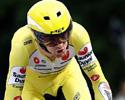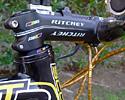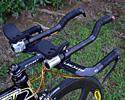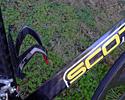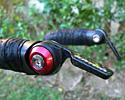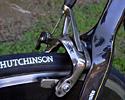
Recently on Cyclingnews.com |
Pro Bikes, June 15, 2007
David Millar's Saunier Duval-Prodir Scott CR1 Plasma TT
Custom carbon speed machineBy James Huang After completing a two-year suspension for a doping violation and being subsequently fired by his long-time Cofidis team, Scottish time trial specialist David Millar returned to the pro peloton in 2006 with a new Saunier Duval-Prodir team, a new Scott Plasma time trial bike, and a new attitude on his illustrious career. Millar fully expected last season to be more of a time to get back into the swing of things than an opportunity to aim for the top step on the podium again, but perhaps even he was surprised at how well, and how quickly, things progressed. After a lackluster (for him, that is) Tour de France return that saw a 17th place finish on the opening prologue and 11th place spot on the second individual time trial, the 2000 prologue winner bounced back with a fantastic win at the 33km Stage 14 time trial of that year’s Vuelta a España only to add a British National Individual Pursuit title as well later that fall. Millar continued his momentum this season with a prologue win at Paris-Nice and he’s already displaying solid form at the Critérium du Dauphiné Libéré. According to Millar, "Last year was hard for me. With two years away from racing, you kind of forget how you did it; I hadn't done a time trial in two years. You can only simulate to a certain degree in training, and it took me until the Vuelta to kind of remember how I did it." In contrast to the common perceptions, Millar doesn't actually overly prioritize aerodynamics when it comes to his bike: "With time trialing, the number one most important thing is position. Now, the bike can get aerodynamic and stuff but it's not really that that's going to make a difference. The only thing that matters in regards to aerodynamics is frontal surface area. What you need… is to get a frame where you're getting your position right, and a good position is basically a compromise between what your most efficient aerodynamics are and where you're most comfortable with getting the power out. A lot of the time, we make the error of basing it all on aerodynamics and then you can't actually get the power out, which is actually what happened to me last year. I spent some time in the wind tunnel, and got this position, but it just wasn't working… I've actually dropped [the height] down again and opened [the arms] right up so it kind of goes against the rules of the wind tunnel but I feel ten times better on it." In Millar's case, that optimum position is surprisingly analogous to that of his standard Scott Addict road stage machine. According to team mechanic Hermann Pacal, "He likes to have the same seat angle position as on the road bike. When he's on a three-week stage race, after two weeks' hard road racing it's very important for him to have the same position. The muscles… everything is already set up for two weeks for the same riding position. So for him, it's a big risk to change the position too much for 50km." To facilitate those preferences, team sponsor Scott Sports supplies Millar with its carbon fiber CR1 Plasma frameset but it's hardly straight off-the-peg. As compared to the stock version's decidedly more triathlon-friendly design, Millar's frame wears a significantly slacker seat tube, a narrower top tube borrowed from the CR1 to minimize contact with his legs, and a head tube that's been shortened by a full 2cm to allow Millar to adopt his characteristically low position. As it turns out, Millar's Plasma is still plenty aerodynamic, but also particularly lightweight (for a TT rig) and stiff. "The Plasma is perfect," he said. "It's incredibly light, but incredibly stiff. Last year, it was 8 kilos exactly; for a full TT setup, that's just crazy talk." That emphasis on rigidity is also played out in his wheel choice: a Mavic Comete carbon disc out back and a five-spoke Mavic Io wheel up front, both of which are supposedly lighter than stock offerings. "Disc is always better in the back. It feels fast and actually it is a lot faster than any other wheel," said Millar. "For the front wheel, I've always preferred carbon… it looks better, when you're looking down it feels faster and it feels better, and I like the rigidity. When you have the full carbon thing on the front, it just feels like a rock when you're accelerating." Rounding out the frameset is a SRAM Force drivetrain (or will it be Red in London?), SRAM TT bar-end shifters and brake levers mounted on a modified Ritchey Hammerhead Carbon TT integrated aero bar, a fi'zi:k Arione saddle, Time RXS pedals, and Hutchinson tubulars borrowed from his road bike "because I'd rather not take the risk of puncturing…especially in prologues, you're going to be taking risks and you need to know the tires and know what their boundaries are." Millar also goes against the fray in terms of gearing, saying "I always have a 39T, a 41T maybe. I'm not one of those guys that likes to have a 44T or 46T on their TT bike; it just makes no sense to me, especially when you're running a straight block in the back, 11-19T or whatever. A lot of people tend to overgear horrendously on the small ring on TT bikes and I just don't understand that. In regards to the big ring, I do like to run a 54T, if it's a flat course a 55T, and that's simply because it means I can keep the chain fairly central… to keep it fluid. I try to always spin, spin, spin. Probably genetically, that's just the way I am. Everybody's got a different morphology, different bodies, different muscle types. But I've always found that if I go in the red once in the first half and overgear on a climb, I never recover, or it takes me so long to recover that I lose the TT." Not surprisingly, one of the time trials that Millar would most like to win this season is the TdF prologue set to go off in London on July 7. How does he hope to win it this year? To prepare, Millar will "go to England two or three weeks before, after Dauphiné, and actually do some club time trials… and I'm going to do some track work because I noticed last year after I did the pursuits at Nationals… the pure speed that I had was just crazy." In regards to the prologue itself, Millar says, "You've got to just hold yourself back; it's what it's all about. I go out in a prologue, and I go, 'hold back, hold back, hold back', literally for the first half, and then the second half go hard." Millar will have stiff competition for the title, however, and even he names David Zabriskie and Fabian Cancellara (Team CSC) as his top rivals. "[Zabriskie] reminds me very much of [Chris] Boardman; he looks amazing on a TT bike. He's a really pure time trialist. He's beautiful on the TT bike. He's powerful, he's smooth, his position's great, his technique is just spot-on. And Cancellara is just a monster." Given his ramp up from the rocky start last year, though, Millar is clearly cautiously optimistic about his chances: "I expect to be much stronger this year." Whatever the outcome, the fireworks will surely be mesmerizing and word has it that Scott will equip Millar with a stunning visual package for the occasion, too. See you in London PhotosFor a thumbnail gallery of these images, click here Images by James Huang/Cyclingnews.com
Images by AFP Photo Images by Fotoreporter Sirotti
| |||||
Full specificationFrame: Custom Scott CR1 Plasma TT Critical measurements Bottom bracket: SRAM Force GXP |
Front wheel: Mavic Io Bars: Ritchey Hammerhead Carbon TT with custom armrests Pedals: Time RXS Total bike weight: 8.1kg (17.9lb) | ||||


